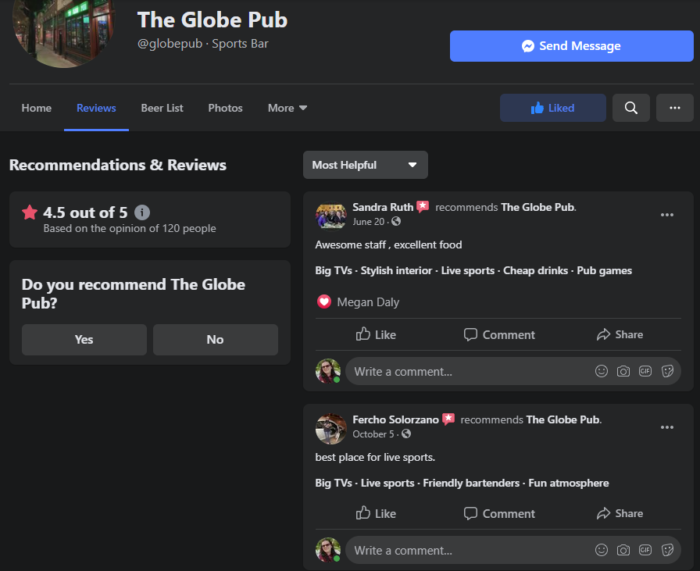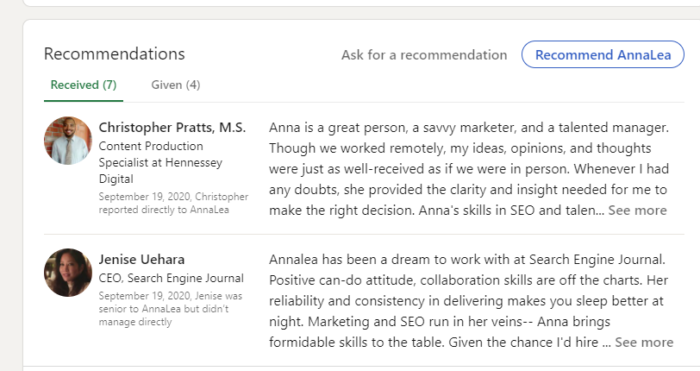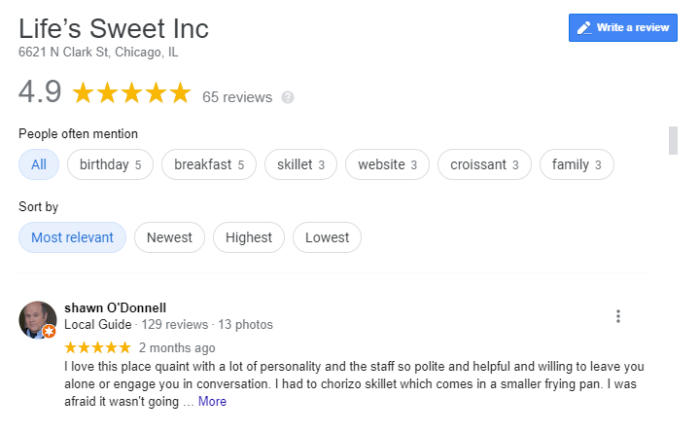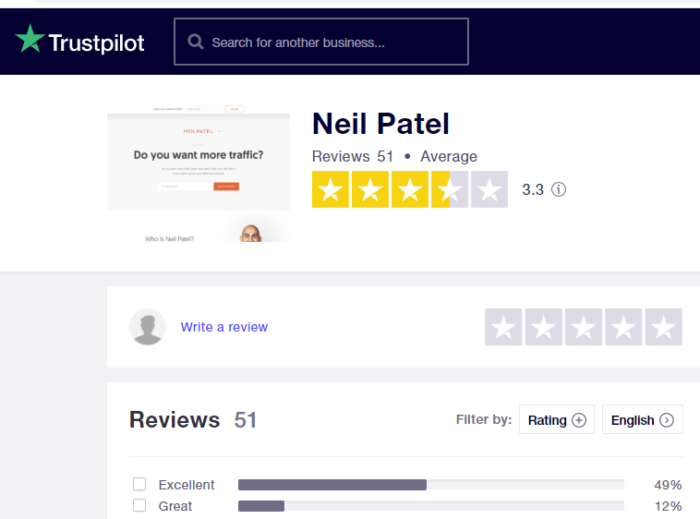
Every great site has a powerful customer testimonial page.
It’s formed by compelling quotes from current customers that make a product or service seem like such an obviously good idea, anyone would sign up.
Great testimonials tell people that your business is not only legitimate but that it actually works.
And testimonials are powerful.
In fact, 92% of customers report they read online reviews before making a purchase decision.
Testimonials boost your conversion rate and inspire trust in your business. But if you don’t have a testimonial page yet, how can you start?
The answer is simple—either feature existing reviews, or kindly ask existing customers to create new reviews for you.
Today, I’ll share some of the top sites you can use to collect customer reviews and how to encourage customers to get more testimonials.
1. Checkout Your Facebook Reviews
The first place you need to look at are sites where people have already given you reviews.
The easiest place? Your current Facebook business page. Especially if you’re a local business, you might already have reviews here that you haven’t noticed.
Facebook testimonials can be quite detailed, making them an ideal way to highlight what your business does best.

If you don’t have reviews on your Facebook page, it’s a cinch to ask people to add a comment. We’ll cover more strategies on how to do this in point six.
2. Look at LinkedIn Recommendations
If you’re a freelancer or are building out the testimonial section for a “work with me” page, LinkedIn is a gold mine of great recommendations and glowing reviews.
All you need to do is ask people to offer a recommendation to you, or use your existing recommendations—in whole or just snippets—as promotion for your services.
Of course, you can’t get reviews on your company profile, since recommendations are only available for individuals.
But if you own a company with many employees, why not encourage all of them to be active on LinkedIn?
This might lead to individual employees receiving recommendations from customers they work with on behalf of your company.

With their permission, you can use these recommendations on your website, either on a testimonials page or a page dedicated to your employees’ bios.
Plus, it wouldn’t hurt for someone who is researching your company on LinkedIn to see your employees have glowing recommendations.
3. Ask for YouTube Video Reviews
What’s stronger than a text-based review? A video of your customer talking about how your products or services have helped them.
Encourage your fans to add videos to their own YouTube account. Let them tell stories about their success and mention your brand, or even encourage video reviews of your product.
If they send you the link, you can add these videos to your channel as favorites and create a playlist of customer reviews. You can also write transcriptions and include them as testimonials.
You can also film reviews on the fly with customers at your store, visitors to your office, or fellow attendees at conferences. Just keep a smartphone with high video resolution handy.
If you have a strong YouTube channel to begin with, people will be happy to be featured on it in exchange for their thoughts.
Because of the closeness of the medium and the sharing potential, videos are one of the best ways to get feedback from your customers.
4. Search Local Search Directories
If you have a local business, then you probably already understand the importance of local search directories.
Sites like Google Business Profiles, Yahoo Local Business, Yelp, and Merchant Circle allow members of their networks to write reviews about local businesses.
Here’s an example of testimonials on Google Business profiles:

If you have great reviews on these sites, you should share them on your testimonials page as well. This can be done by copying and pasting, taking screenshots of reviews, or using a WordPress plugin to show Google reviews on your website.
If you don’t have reviews there yet, this is a great way to recommend people leave you a review. Not only will you get to include it on your site, but it’ll also be available in searches.
Today people rely more and more on Google’s ratings to decide which merchants to visit. By getting as many reviews as possible, you can keep your business high in the search results.
If you’re just starting, set up a basic account on those sites and start encouraging customers to review you there.
5. Don’t Forget About Niche Review Sites
Depending on your business’ industry, you may want to focus on getting reviews on niche review sites that your target audience frequents.
While sites like Google, Yahoo, and Yelp apply to all kinds of local businesses, there might be others that cater to your specific industry.
Hotels, for example, would want great reviews on sites such as Expedia, Travelocity, and TripAdvisor. Landscapers and painters might refer to Thumbtack, and so on. Our agency has reviews on Trust Pilot.

Since many people get their first impression of your services from these sites, it’s a good idea to focus on building a quality reputation there, then copying the reviews to your site.
6. Reward Customers Who Review
Considering all the benefits of getting customers to provide great reviews for your site, how can you encourage them to start posting their thoughts?
If possible, offer a clear incentive for posting a review. For example, fast food restaurants often offer customers a chance to win a cash prize by filling out an online survey.
You can apply the same concept to encourage online reviews. A few examples include offering coupons, special deals, or even a discount on the next purchase with proof of a review.
Just make sure to review the terms and conditions of the site you want to offer incentives on. Some, like Yelp and Google, ban offering direct incentives. However, you can usually add a line to your receipt or a sign in your store asking customers to leave a review.
If you do decide to reward customers who review, it’s a good idea to disclose that in the testimonial.
7. Setup Google Alerts and Social Mentions
Last, but not least, there are likely a ton of unsolicited customer reviews written about your company on other sites, such as personal blogs and forums.
These can be great opportunities to link to from your website because they are clearly unbiased reviews.
When they’re published on another site, people can say whatever they want and you don’t have control over what they’ve decided to write about you.
How do you find these third-party reviews? Simple.
Set up daily email notifications through Google Alerts and Social Mention. Choose a few terms like your personal name, business name, brand, and specific products.
You can also include a few keywords if applicable. And it’s a good idea to include the word “review” for anything so broad it’ll track articles not specifically about your company.
Once you get these reviews, you can ask the people who have mentioned your brand if you can feature their comments or story on your testimonials page.
Usually, people are happy to oblige, especially in exchange for a link from your site.
How to Create Your Testimonials Page
Now that you’ve collected your reviews, it’s time to place them all on one easy-to-access page.
According to a recent study, 91% of 18- to 34-year-olds trust online reviews as much as personal recommendations, so it’s important to make this as easy to find as possible.
The goal of the testimonial page is to make it easy for visitors to see your most glowing testimonials all at once, instead of needing to search the Internet to see the positive things people are saying.
Make sure to credit the original site of the review. If it came from Yelp, LinkedIn, or another site it’s polite to link back to the original source.
The added benefit of linking is that you might encourage more people to leave reviews once they’ve seen what everyone else has to say.
And if necessary, you should always ask permission before posting third-party reviews to your website.
But once you get that permission, don’t hesitate to promote your review page! You worked hard to create a great product or service others are excited about.
You earned it; don’t be afraid to share.
Conclusion
If you want to add a layer of credibility to your site, you need to build out a solid testimonial page. Testimonials build up the social proof that increases sales and conversions.
The quickest and easiest way to do this is by finding existing reviews from around the web and compiling them onto one page of your site.
You can check out social networks like Facebook and LinkedIn, as well as specific sites like maps locations, search directories, and niche review sites.
To take things to the next level, ask existing customers to leave customer testimonials for your business.
One of the most powerful formats is through YouTube videos, since it’s a more intimate medium where you can see and hear the person describing the details of the product.
If you’re still struggling to get reviews, you can consider offering a reward to customers who provide you with a review — just make sure its allowed if you ask them to leave testimonials on sites like Yelp or Google.
Finally, keep your eyes peeled by checking on any media mentions that might be floating around online.
How will you encourage customers to leave testimonials?
The post 7 Strategies for Getting More Customer Testimonials (And What to Do With Them) appeared first on Neil Patel.
via https://AiUpNow.com December 9, 2020 at 11:11AM by Neil Patel, Khareem Sudlow,
